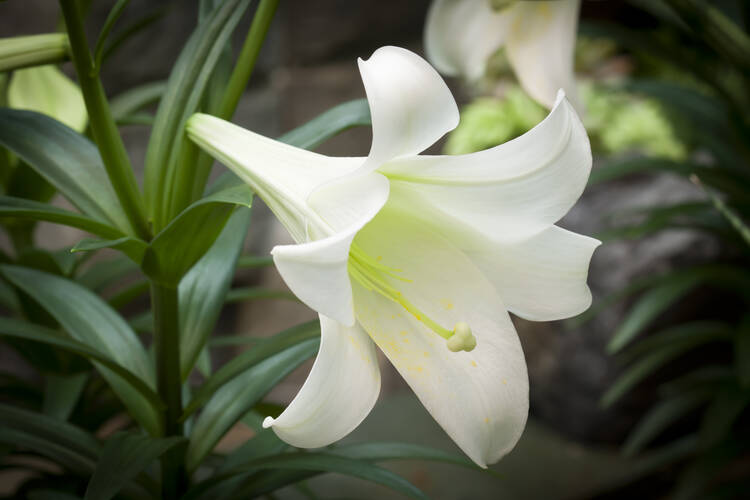When it comes to Easter Sunday, Christians around the world can look forward to many of the same experiences: children jittery from some wicked cocktail of milk chocolate and confectionary sugar; a much-welcome explosion of color and style in the congregation matched by the joyous ringing back in of the Alleluia; and the dignified grace of Easter lilies, their silky bugle-shaped whiteness silently trumpeting the new life we have gained through the faithful love of Jesus.
One fact many Christians do not realize is that they also share in where those lilies come from and how they were grown. Almost every lily any of us in the United States will see this Easter or have seen most any Easter of our lives, in fact, has come from the very same tiny area at the northwest border of California.
To the extent that people know Del Norte County, Calif., at all, it is generally because of the region’s main tourist attraction, giant redwoods that soar some 350 feet into the sky, or the Smith River, the cleanest (and many claim the clearest) wild river in the United States. It is one of the West Coast’s most significant salmon and steelhead fish beds.
Almost every lily any of us in the United States will see this Easter has come from the very same tiny area at the northwest border of California and Oregon.
But in fact the Smith River area also produces somewhere between 95 and 98 percent of all Easter lilies sold in the United States, up to 14 million bulbs a year, all on just four family-owned farms using a couple thousand acres.
It was not always this way. In fact, while the lily has been associated with Jesus and his resurrection seemingly from the first days of the church, Easter lilies only found their way to the United States toward the end of the 19th century, when a Philadelphia woman visiting Bermuda fell in love with the plant and talked a nursery back home into forcing some into flower for spring.
Decades later, as World War I ended, veteran Louis Houghton brought a suitcase of bulbs to friends and family on the southern coast of Oregon. Originally native to the southern islands of Japan, the plants thrived in the rainy, consistently mild climate of the California/Oregon border. (It never gets much above or below 56 degrees here all year round.) And local farms began popping up all along the Pacific, from Long Beach, Calif., to Vancouver, British Columbia.
When the 1941 attack on Pearl Harbor ended trade between the United States and Japan, the economic potential on such farms escalated. “All of us Catholics obviously still wanted our lilies,” explains Del Norte County Supervisor Chris Howard. “And it became one of those things people wanted to capitalize on.” Before long there were over 1,200 different growers.
But despite the demand, over time the number and location of Easter lily farms diminished dramatically to just a handful of growers. Producing Easter lilies is a demanding process. Bulbs take three to five years to reach maturity, upwards of 1,000 days underground. Yet they never go dormant; they require regular care, repeated replanting and are at risk for any number of different infestations or fungal infections.
Lilies by nature also bloom in the summer, not spring, making their readiness each year for Easter a feat in itself. Bulbs are harvested between August and November, then shipped to greenhouses where they are kept cool and moist until Easter approaches, at which time changes in temperature are used to speed or slow growth, so that they can bloom precisely for the feast.
For as much as Christians look to the lily as a sign of faith confirmed and life renewed, it is an at-times brutal irony that the Easter lily industry finds itself in many ways much closer to Gethsemane. Bulb prices are largely controlled by big box store distributors whose constant promise of ever-lower prices leave the growers struggling to stay in the black.
Meanwhile the needs and practices of the lily farmers have brought them into conflict with environmental groups who believe the massive amounts of pesticides being used to protect the plants (some 300,000 pounds per year) not only threaten the Smith River and its wildlife but are likely responsible for a host of health issues among the less than 1,000 residents in in the area. They range from exacerbated allergies to miscarriages and cancers. Residents tell stories of high winds blowing powerful pesticides onto their cars and into nearby school yards.
Despite such concerns, even the area’s main environmental action group insists they want the industry to succeed. “We’ve asked people not to sue,” Siskiyou Land Conservancy Executive Director Greg King explains. “We want to try and create a negotiated settlement to allow the lily growers to remain in business. We don’t want to threaten their very marginal bottom lines. We know they’re not getting wealthy.”
“Do not worry,” Jesus urges the disciples. “Consider the lilies, how they grow: they neither toil nor spin; yet I tell you, even Solomon in all his glory was not clothed like one of these. If God so clothes the grass of the field...how much more will he clothe you?” (Lk 12:22, 27-28) On Easter Sunday Christians will celebrate once again the manifested truth of this statement of faith.
Meanwhile in a small and beautiful but mostly unknown region of northwest California and southwest Oregon, for now, considering the lilies will require both toil and that faith.











Don't forget the Christmas tree. Our eco-system is plenty stressed with providing for our decorating and commemorating needs.
This makes me feel much better since I don't purchase lilies due to allergies. Instead, spring flowers -- a beautiful sign of rebirth in our northern area -- that can be replanted and enjoyed every year to remind us of how we must be patient. The flowers often reappear right around Easter.